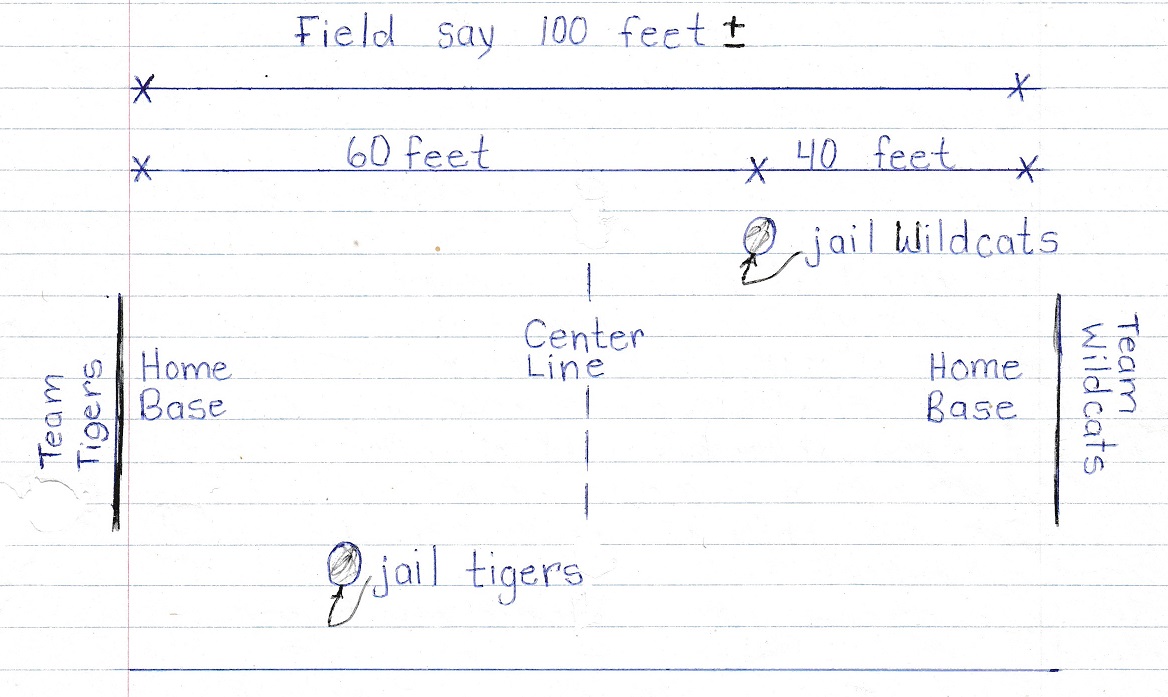
Field: Larry can be played on any reasonably level field or on the road (and sometimes on meadows after they have been cut). One frequently used area was Little Merasheen beach.
The length of the playing area would be decided by the players and could vary from 100 to 150 feet. The width of the field would be 50 or 60 feet. Limits or boundaries of playing area was agreed-upon but was not always kept as many players chasing and being chased would run away and not be seen again until the next evening.
Home base: Can be any long object you can touch with your hands or feet. This could be a fence, the side of a building or a stick of wood or a long log on the ground.
Jail: An area on each side of the field for each team to put their prisoners which they capture. As in the sketch, the Wildcats jail is in their half of the field close to their homebase so they can also guard their prisoners. Same for the Tigers. Jail was usually a mark such as a rock, barrel, or stick. Opposite team would chase them and try to catch them before they got back to their homebase.
Centre line: A centre line of the field was located, understood or marked. This line is used as a guide for when a player reaches or crosses the centre line a faster runner or a player from the opposite team would chase them and try to catch them before they got back to their home base.
Teams: two team captains or two people were agreed on to pick teams or sides. As games can be played when say six or eight to twenty or more people would gather and decide to play a game of Larry. Usually we would play in Merasheen in the evening when the weather cooled off. We would also agree from evening to evening as to a time everyone will try to gather at the playing field usually 6:30 or 7 PM.
Team captains picked in turn from the players gathered around at the start of the game until all players were picked. As new or late players arrived, they joined the team due for the next pick to avoid confusion. About 8 or 10 players on a team is enough.
Playing: The teams would line up at their home base. A player, on say the Tigers, would leave homebase and dare a player from Wildcats to try and catch or capture them.
Any players that leave their home base after or later than players on the opposite team have the right to capture any person or players they can catch on the opposite team due to the fact that they touched or left their home base last.
Players captured are prisoners and are brought to their team’s jail. Players walking towards their jail with a prisoner are safe and cannot in turn be captured.
Players will run onto the field getting players to chase them back onto their half of the field and hope that a team member will leave their home base and catch the person chasing them.
The game can get confusing at times as players try to remember the players they can try to capture on the field who have left their home base before them. Many players captured will argue they left their home base after the person trying to put them in prison.
Other players will try to help in deciding who should go to jail. Most of the time the decision is made on one’s honour.
The object of the game is for one team to try and put all the players of the other team in their jail.
When a player is put in the Tigers jail, a tiger player or a guard is assigned to guard the prisoner. The guard could usually drive away players trying to remove their team members in jail because they have a shorter distance from their home base. If a player can run to the jail escaping the guards and touching their team member in jail first, they can remove their team player from jail. They both return to their home base and continue playing on the field.
Larry is good fun, good exercise, and plenty of running. It can get somewhat confusing when too many players play as they lose track of when players on both teams touch or leave their home bases.
Note: Tigers and Wildcats were actually Merasheen softball teams in the early 1950s with uniforms and all.
By Ernie Walsh for 1990 Reunion